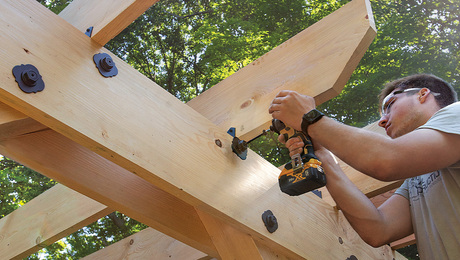Hi guys,
I want to get some feedback on what you guys would do. Here I have a client who wants garage to be raised to alley level in order to not have a steep slope into garage. Currently the grade of their backyard is about 4′ lower than their alley.
I’m thinking of using concrete blocks as the foundation, bring that up to 4-5 feet or whatever is necessary to create a proper pitch to drain water away from garage, once block perimeter is built, bring in soil, compact, class 5, then pour the 4″ thick slab.
What do you guys think?




















Replies
First, I'd invert the garage so it does not fall off the foundation.
In this area, I'd stack 2 man rocks along the property line, then go on CL and have whoever is offering free delivered soil to fill in the entire back yard to alley level.
If this is a new garage, that is the way to go. Build your stem wall, back fill with dirt, compacted in lifts, pour a slab and build your garage. That is a popular technique here in SW Florida. My wife built over 100 houses that way.
Do not use soil...
Your on the right track...make sure your block wall has proper reinforcement - it will be under pressure from the compaction process.
You should use a proper compactable fill....just plain old soil is not a good choice. Talk to your local rock or concrete supplier. The most basic fill of this type locally here is called "pit run". I'm sure it's called other names in other parts of the country. It's a mixture of sand and crushed rock - the fine material that's left after the rock crusher is done. Your local supplier will be able to help you out. Be sure to rent a flat plate compactor to do the job and run it across the fill every 4-6" layer. Also, make sure the material is damp (not wet and not dry) to allow for maximum compaction.
If it's not properly compacted, with fill of 4', you will get settlement under your slab. I just helped a neighbor with exactly this problem..concrete driveway had settled over 5" down from garage slab...when we pulled the drive out, there was a 5" void under the garage slab that went back 15' into the garage - had to drill the slab 18" on center and injected a foam slurry to re-support the slab. A very expensive process that could have been avoided had the original contractor used the right backfill material and had it properly compacted. And we're not sure the settleling has finished
Good luck..
I sometimes forget, dowelled, grouted cells are not standard in places without a wind code.
My first thought is that if you stack blocks up 5' high them compact dirt inside them, they'll just blow out.
My preference would be to bring the whole area up to the grade you want with compacted fill. Then do normal footings and slab.
If you dowel the cells every 4 ' or so with a #5 and pour them solid, the wall will not blow out. I am not sure if that is really necessary for a stem wall but it is code here for all walls and stem wall construction with backfill is very common here.
Block walls
Block retaining walls are built all the time.
You know, it might not be silly to consider building a self-supporting floor. This is done fairly often, to make the space below available for storage, and might be the best option even if the storage is not needed, as it eliminates a number of costs and concerns with using fill.
Subfloor.
I built a garage not too long ago on a site that sloped away from the drive way by 8'. Retaining that amount of compacted fill was not practical. Nor was grading a pad. With only a small amount of engineering we were able to build on a raised sub floor. Vehicle loads are great, but we had no need for large clear areas underneath. I think we used 2x12 joists @ 12" oc with 1 1/8" plywood. Girders were 4' oc with posts 4' oc. No soils work or retaining walls were required. A wood floor in a garage requires a fireproof coating. We used a trowel on cement product that had the advantage of water proofing the floor as well. This was by far the most economical solution.